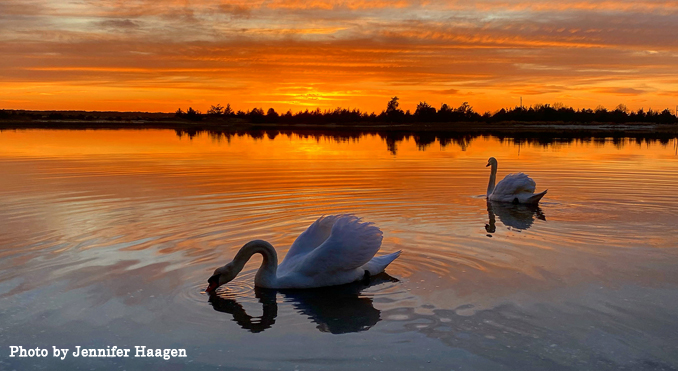
Winter 2021: The Mute Swan’s Preening Ritual
Happy New Year everyone. I hope you all had a wonderful holiday, and you’re as eager as I am to get 2021 off to a positive start. The past year has been exceptionally rough for most folks in one way or another, but brighter days are ahead, so just keep hanging in there.
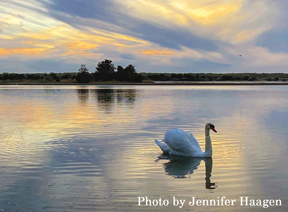 A wildlife rescue responder friend of mine Jenn, sent me a photo showing a swan who had a few feathers stripped, and she wondered if they would repair themselves. She has a very close connection with a pair of swans near her home, and has a wonderful talent for photographing her friends in some beautiful local settings. I thought this month would be a great opportunity to showcase a few of Jenn’s beautiful photos, and also talk about feather repair or replacement in swans and most other birds. This is more commonly refereed to as “preening”. I’ll be using the beautiful Mute Swan as a general example, because like them and most of our local waterfowl, they can be seen preening pretty much all the time.
A wildlife rescue responder friend of mine Jenn, sent me a photo showing a swan who had a few feathers stripped, and she wondered if they would repair themselves. She has a very close connection with a pair of swans near her home, and has a wonderful talent for photographing her friends in some beautiful local settings. I thought this month would be a great opportunity to showcase a few of Jenn’s beautiful photos, and also talk about feather repair or replacement in swans and most other birds. This is more commonly refereed to as “preening”. I’ll be using the beautiful Mute Swan as a general example, because like them and most of our local waterfowl, they can be seen preening pretty much all the time.
Preening is absolutely necessary and vital to a swan and its plumage (feathers collectively). It promotes waterproofing, cleanliness and the overall health of feathers. It’s even an important part of a swan’s social life. Preening together is a sign of acceptance. The swan has an amazing 25,000 plus overlapping feathers that make up its plumage. Each feather is replaced annually throughout the year, so that answers Jenn’s question, but it’s the daily ritual of preening that can really be quite interesting.
 Those of you who have seen a swan’s preening ritual may have enjoyed the birds beautiful dance and fluent movements, but do you know what the bird is actually doing? After all, it is a required job, and a big one. Each feather is preened one at a time. This includes inspecting, cleaning, grooming and repositioning back to its normal position among its 25,000 companions.
Those of you who have seen a swan’s preening ritual may have enjoyed the birds beautiful dance and fluent movements, but do you know what the bird is actually doing? After all, it is a required job, and a big one. Each feather is preened one at a time. This includes inspecting, cleaning, grooming and repositioning back to its normal position among its 25,000 companions. 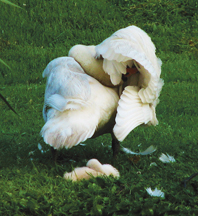 Preening is a natural instinct. New born cygnets (baby swans) only a few hours old will preen. This gets them ready for the water in less than 24 hours, however anytime within the first 72 hours after hatching is acceptable for the cygnets to get in the water. Water-proofing is a key element of necessity before a cygnet leaves the nest. If water-proofing is not satisfactory, the tiny cygnets will become wet and cold, putting them at risk. Cygnets are unable to thermo-regulate for the first month, so staying dry and warm is most important.
Preening is a natural instinct. New born cygnets (baby swans) only a few hours old will preen. This gets them ready for the water in less than 24 hours, however anytime within the first 72 hours after hatching is acceptable for the cygnets to get in the water. Water-proofing is a key element of necessity before a cygnet leaves the nest. If water-proofing is not satisfactory, the tiny cygnets will become wet and cold, putting them at risk. Cygnets are unable to thermo-regulate for the first month, so staying dry and warm is most important.
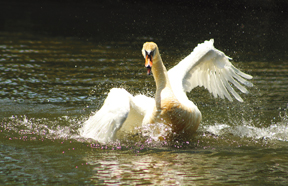 This is a general preening process; first comes the bath. Bathing encourages preening while preening promotes water-proofing. The bath can be achieved a number of ways but the objective is to get ALL the feathers wet. Whether flopping, splashing, dipping, diving, the act of bathing is exciting and action packed. I LOVE to photograph swans and ducks at high speed while they carry on bathing. Their expressions are often equally entertaining. Once the feathers are washed, the swan will usually swim off with a mate, other accepted swans, or even alone to shallow water or a favorite low bank preening site. It’s there that a swan will begin its daily ritual of preening.
This is a general preening process; first comes the bath. Bathing encourages preening while preening promotes water-proofing. The bath can be achieved a number of ways but the objective is to get ALL the feathers wet. Whether flopping, splashing, dipping, diving, the act of bathing is exciting and action packed. I LOVE to photograph swans and ducks at high speed while they carry on bathing. Their expressions are often equally entertaining. Once the feathers are washed, the swan will usually swim off with a mate, other accepted swans, or even alone to shallow water or a favorite low bank preening site. It’s there that a swan will begin its daily ritual of preening.
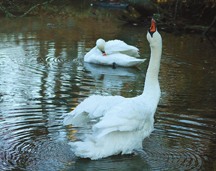 Unfolding the wings or poking its long beak into ta thick layer of feathers, the swan cleans each feather from base to tip. Once a section, row or area of feathers are cleaned, the swan then begins water-proofing. Water-proofing is achieved by coating each feather with a waxy oil that is produced from the Preening or Uropygial Gland, which is a nipple-like protrusion located under a flap of feathers near the tail. The flap of feathers lift up to expose the gland, and the swan uses its head, beak and neck as an applicator. This is where their beautiful dance can set a human observer into a trance. The visual of a swan painting every inch of its body with an invisible oil that makes it possible for one of our largest birds to achieve maximum buoyancy, can be one of the most beautiful sights in nature. With no hands, yet a long and incredibly flexible neck, it’s amazing how it can reach every part of its body. Twisting, stretching with an occasional re-dipping to keep the feathers from prematurely drying are among the preening swan’s various poses.
Unfolding the wings or poking its long beak into ta thick layer of feathers, the swan cleans each feather from base to tip. Once a section, row or area of feathers are cleaned, the swan then begins water-proofing. Water-proofing is achieved by coating each feather with a waxy oil that is produced from the Preening or Uropygial Gland, which is a nipple-like protrusion located under a flap of feathers near the tail. The flap of feathers lift up to expose the gland, and the swan uses its head, beak and neck as an applicator. This is where their beautiful dance can set a human observer into a trance. The visual of a swan painting every inch of its body with an invisible oil that makes it possible for one of our largest birds to achieve maximum buoyancy, can be one of the most beautiful sights in nature. With no hands, yet a long and incredibly flexible neck, it’s amazing how it can reach every part of its body. Twisting, stretching with an occasional re-dipping to keep the feathers from prematurely drying are among the preening swan’s various poses.
Even more interesting is when multiple swans are preening together. It is quite common to see swans conducting the ritual in what appears to be a choreographed exchange. Actually, preening is an important social behavior as well. Swans, which are generally territorial throughout the year and absolutely during the breeding season, can use the ritual of preening as an opportunity to be accepted into an area occupied by other breeding pairs. On the other hand, it can be an opportunity to learn that a particular swan or pair might not be as friendly and much more territorial. A swan does communicate with a variety of swim patterns and plumage arraignment displays, so continuing to communicate through movements during preening shouldn’t be a surprise.
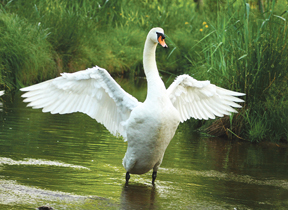 My favorite part of the preening process is at the end. This is when the swan must reset all the clean and preened feathers back in each overlapping order to ultimately rest in its normal state. When properly water-proofed, the swans massive body becomes a grand vessel of buoyancy. This also allows the swan to cut through the water at a fast speed when necessary as well. The swan achieves total feather alignment by shaking, twisting and fluffing its feathers in a powerful display, only to end gently with placement perfection.
My favorite part of the preening process is at the end. This is when the swan must reset all the clean and preened feathers back in each overlapping order to ultimately rest in its normal state. When properly water-proofed, the swans massive body becomes a grand vessel of buoyancy. This also allows the swan to cut through the water at a fast speed when necessary as well. The swan achieves total feather alignment by shaking, twisting and fluffing its feathers in a powerful display, only to end gently with placement perfection.
The swan will start with fast twisting from side to side with neck fully extended, looking straight up. This helps fluff the feathers out. The fluffing pulls air under the freshly preened feathers and settles the body and wing feathers into the proper position and a nice neat order. To layer the wing feathers properly, the swan will raise its upper body up high, and with a quick and powerful session of mighty wing flaps that start slow and end fast, the wing feathers are all set in perfect overlapping order.
A healthy swan will preen at least 2 hours a day. Each feather lasts a year and must be cared for diligently. Swan feathers are a brilliant white, covering the swan from ankles to face (cheeks). Their wing feathers are light weight and quite strong. Besides being a key appendage for flight capabilities, feathers protect birds from elements like heat, cold, rain, snow, and wind. Even small hail will bounce off the protective shielding of a swans wing and body feathers. Most importantly, properly water-proofed feathers keep the insulating down feathers from becoming wet. Frayed, worn out feathers are much harder to keep properly water-proofed. After awhile these worn feathers will collect minerals from the water, turning their striking white plumage to a duller shade of beige. The larger feathers will also become pointed and lacking feather structure.
Dark red or brown staining on the lower body, chest or head of a swan indicates attaching iron deposits from the water source in which the swan frequents. The diluted iron attaches to worn feathers on the swan’s head and then rusts, due to the exposure to air. This creates a rusty red crown or a “Red Cap”. This will all go away when the swan moults, usually in June. Preening increases during this phase and all the frayed, worn and broken feathers are replaced with nice fresh new growth.
Genetically, birds are more closely related to reptiles than mammals, therefore they do also shed their feet skin, even their beak. This allows for repairing of injuries or worn scaly skin. So basically, the swan gets an entire new outer coat annually, which lends to its year round beauty. That’s pretty amazing.
A Happy & Healthy New Year Folks. Thanks to Jennifer Haagen of East Hampton, for lending me a few of her amazing photos for this piece. Remember folks, Wildlife Matters.
~ Dell Cullum
Hampton Wildlife: 631-377-6555 · Wildlife Rescue of East Hampton: 844-SAV-WILD
www.WROEH.org · www.ImaginationNature.com

